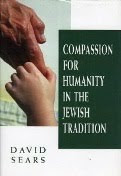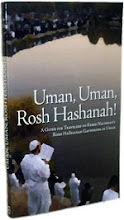By Dovid Sears
L’ilui nishmas Shulamis Na’ami bas
Gedaliah Aryeh (Sochaczewsky), a”h
Most Breslover chassidim (and many “misnagdim”)
are familiar with Rebbe Nachman’s hispa’arus—his seeming self-praise. One
such remark recorded by Reb Noson is that Rebbe Nachman received his teachings
from a “place” from which no other tzaddik had ever received (Chayei Moharan
#353, hashmatah). Some take these statements to indicate disrespect for
other tzaddikim, or to lead to the conclusion that the Rebbe’s leadership is of
an exclusive nature. Both conclusions would be entirely erroneous. And such errors
could be extremely damaging.
First of all, Rebbe Nachman did not
see himself as the “tzaddik ha-dor” to the exclusion of others, but
acknowledged and praised many of his contemporaries, as well as tzaddikim of
the recent past.
In Chayei Moharan #353, Reb Noson
relates some of the praises of Rebbe Nachman for his holy great-grandfather,
the Baal Shem Tov (whose spiritual rung he identifies with the sefirah of Binah
that is above Chokhmah; see below); the Maggid of Mezeritch (whose spiritual
rung he identifies with the sefirah of Chokhmah); and his uncle, Reb Borukh of
Medzhibuzh (whose spiritual rung he identifies with the sefirah of Binah that
is below Chokhmah). (It seems that “Binah above Chokhmah” is a way of
describing the sefirah of Keser, since both are termed “makifin,” or
“encompassing lights”—Binah in relation to the seven lower sefiros of
ChaGaS-NHYM, and Keser to the entire array of sefiros from Chokhmah to Malkhus.
Thus, the Rebbe’s remarks may be understood as saying that the wisdom of the Baal
Shem Tov included everything that would subsequently be revealed or developed
by the other Chassidic masters. And he implicitly designated the Maggid and Reb
Borukh as outstanding figures in the dissemination of the Baal Shem Tov’s
“encompassing light.”)
The Rebbe was born and raised in the
Baal Shem Tov’s house in Medzhibuzh, met many of the surviving disciples of
both the Baal Shem Tov and the Maggid during his childhood, including the
elderly Toldos Yaakov Yosef, and he used to pray at length beside his
great-grandfather’s grave (Shivchey ha-RaN #19). (For a discussion of the ancient
Jewish practice of praying beside the graves of the tzaddikim, see Rabbi
Gedaliah Kenig, Chayei Nefesh, sec. 32-36, as found in Shaarey Tzaddik, Vol.
III, which cites a number of primary sources.)
In Chayei Moharan #553 (in the
editor’s note), Rebbe Nachman’s praises of other Chassidic masters are also
enumerated, including a number of his living contemporaries. He described Reb
Levi Yitzchok, the Berditchover Rov, as “unique in his generation” (also see
Chayei Moharan #270, where he compared the Berditchover Rov to the Tefillin of
the Jewish people); regarding the Maggid of Mezeritch, “one may believe
anything [said about his spiritual attainments or alleged miracles]”; he
extolled the Baal Shem Tov in the highest terms (also see Chayei Moharan #280
re. the uniqueness of the Baal Shem Tov); and he declared that Reb Pinchos of
Koretz was at one time the greatest tzaddik on earth, adding, “Happy are the
eyes that beheld Reb Pinchos!” As for Rabbi Yaakov Yosef of Polonoye (author of
Toldos Yaakov Yosef and other early Chassidic classics), “All his works are
holy and wondrous—but the tzaddik himself was much higher!” He had similar praises
for the Rebbe Reb Elimelekh of Lizhensk (author of Noam Elimelekh), and the
latter’s brother, Reb Zushe of Annipola.
Other Chassidic masters whom Rebbe lauded
are mentioned in Chayei Moharan #553. They include Reb Michel of Zlotchov; Reb
Avraham of Kalisk; Reb Menachem Mendel of Vitebsk; Reb Nochum of Chernobyl; the
Rav of Neshchiz; the Rav of Alik; the Rav of Kozhnitz; the Rav of Lantz and
Lublin; Reb Aharon of Titiev; and the Rebbe’s uncle, Reb Moshe Chaim Ephraim of
Sudylkov.
In Chayei Moharan #410, the Rebbe
contrasts philosophical writings with those of tzaddikim: first and foremost, Chazal;
the kabbalists (Zohar, Arizal); and specifically, Likutey Amarim (Maggid of
Mezeritch), Toldos Yaakov Yosef, and the teachings of the Baal Shem Tov (as
found in various early Chassidic works).
In addition, there are well-known
Breslov oral traditions about the Rebbe’s friendship with the Baal ha-Tanya and
his praises of the older Chassidic leader. Rebbe Nachman and the Baal ha-Tanya
each spent a Shabbos with the other, and according to Breslov tradition, the
Rebbe took the Baal ha-Tanya to some of his wealthy supporters to solicit
donations for Chassidic immigrants in the Holy Land, introducing him as “a true
talmid chokhom” (probably in both senses of the term: a master Torah scholar
and a “disciple of the wise,” meaning the Maggid of Mezeritch and Reb Mendel of
Vitebsk, among others).
In Shivchey ha-RaN #20, it states
that after his marriage, when the Rebbe moved away from Medzhibozh, he used to
visit the grave of Reb Yeshaya of Yanov, a disciple of the Baal Shem Tov buried
near his new home.
Much is made of the Rebbe’s remarks
that his path went beyond that of his great-grandfather (e.g., Chayei Moharan ##381,
393). However, Breslover friends who were close to Reb Levi Yitzchok Bender,
zal, have told me that Reb Levi Yitzchok often pointed out that of all Chassidic
groups today, Breslov is closest to the “derekh ha-Baal Shem Tov,” and brought
various proofs to support his claim. The Rebbe was very much a product of the
Baal Shem Tov’s “cheder,” and his teachings were intimately connected to those
of the Baal Shem Tov.
Reb Noson’s illustrious disciple, Reb
Nachman Goldstein, the Rov of Tcherin, in addition to his commentaries on
Likutey Moharan and other Breslov works, authored two popular anthologies of
non-Breslov Chasidic teachings: Leshon Chassidim, which collects teachings of
disciples of the Baal Shem Tov, and Derekh Chassidim, which collects teachings
from disciples of the Maggid. These teachings are arranged alphabetically by topic and to those knowledgeable
in Breslov Chassidus, implicitly show the many resonances between Breslov and
the other early Chassidic writings.
When I lived in Borough Park in the
1980s, I once asked the prominent Breslover, Rabbi Shlomo Chaim Vitriol, why
the Tcheriner Rov created these two works. Was it so that his fellow Breslovers
would realize how connected we are to the other schools of Chassidus, or to
show other Chassidim how the teachings of the Baal Shem Tov and the Maggid and
his talmidim are kindred to those of Rebbe Nachman? Reb Shlomo Chaim immediately
said, “Both are true!”
Beyond this, the Rebbe taught that we
should love and revere all of the tzaddikim. He cautions, “Never say ‘this
tzaddik is appealing (tzaddik na’eh), but that tzaddik isn’t appealing.’
” This seems to reflect the concept he discusses in Likutey Moharan I, 64:4
(based on kabbalistic principles), that despite all appearances, the tzaddikim
are one. Elsewhere, he states that the seeming strife between the tzaddikim is
only due to our pgam (deficiency) (Likutey Moharan I, 5:4; also see
Likutey Moharan I, 56:8, which discusses strife (machlokes) and the higher
knowledge (da’as), as personified by Moshe, in which contradictory
viewpoints coalesce.)
This isn’t merely theoretical. In
Chayei Moharan #101 (BRI English translation, #227), Reb Noson preserves one of
Rebbe Nachman’s dreams. The soul of a former disciple appears before the Rebbe,
complaining that he has gone astray because he lost faith in the Rebbe. “Is
there no one besides me to go to?” the Rebbe asks. “If you don’t believe in me,
go to one of the other tzaddikim!”
Certainly, Breslover chassidim
believe that Rebbe Nachman is the tzaddik emes, from whom all receive,
whether they know it or not (Likutey Moharan I, 70). This tzaddik
is compared to the yesod ha-pashut, the unitary “primal element”
from which the four elements of earth, water, wind and fire derive (Likutey
Moharan II, 66, 67). But when understood in the light of Rebbe Nachman’s broader
teachings, this belief should unite us, not divide us. Kulam ahuvim, kulam kedoshim,
all are beloved, all are holy.














No comments:
Post a Comment